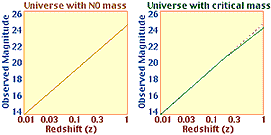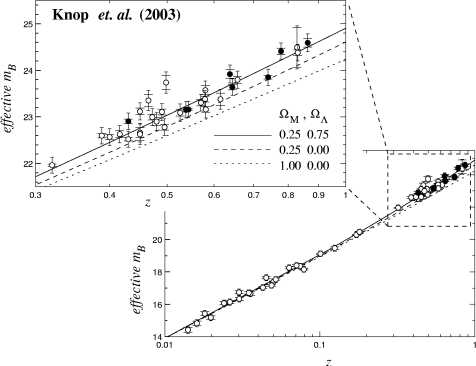![]()
![]()
Isaac Newton (1642-1727), professor at Cambridge, England, and many of his colleagues presumed that light was composed of small weight particles which could be attracted by gravity. John Michell, also of Cambridge, wrote a paper in 1783 proposing that a star with sufficient mass and compact enough could have such a strong gravitational force that light could not escape. Any light emitted from the star would be dragged back into the star by the star’s gravity. Such stars would not be visible because no light from them would reach us although they might still exert gravitational effects on other nearby masses. But eventually it was determined that light is not composed of particles with mass.
 In 1928 Subrahmanyan Chandrasekhar (1910-1995, at left), a graduate student from India, voyaged to Cambridge, England, to study with Arthur Eddington who had become widely regarded as one of the few experts on general relativity. Earnest Rutherford, another Cambridge scientist, had recently confirmed that if atoms were bombarded by protons, sometimes a proton would combine with an atomic nucleus making an atom of a heavier element and releasing considerable energy. There was speculation that stars such as the Sun might use this process to produce their radiant energy by fusing the protons in Hydrogen nuclei together to make Helium. During this process the pressure due to the energy released would prevent a star from shrinking much in size. During his voyage, Chandrasekhar estimated how big a star would be once it had used up its Hydrogen. Pauli's exclusion principle prohibiting particles with the same quantum numbers from occupying the same space would seem to limit the shrinking of such an exhausted star. But Chandrasekhar realized that there is a limit to the repulsion provided by this exclusion principle. Chandrasekhar calculated that a cold star of more than about one and a half times the mass of the sun would not be able to support itself against its own gravity. The Russian scientist Lev Davidovich Landau (1908-1968) made a similar determination. A star small enough to be supported by the exclusion principle repulsion between the electrons matches what astronomers call a white dwarf. The sky reveals a large number of these white dwarf stars; one is a companion star orbiting around the brightest star, Sirius. Landau pointed out that a smaller final state was possible for more massive stars. If gravity caused their electrons to fuse with protons to form neutrons, they neutrons could similarly be supported by the exclusion principle repulsion between neutrons. It was predicted that these neutron stars would not give off light so would be invisible. (Today we can
In 1928 Subrahmanyan Chandrasekhar (1910-1995, at left), a graduate student from India, voyaged to Cambridge, England, to study with Arthur Eddington who had become widely regarded as one of the few experts on general relativity. Earnest Rutherford, another Cambridge scientist, had recently confirmed that if atoms were bombarded by protons, sometimes a proton would combine with an atomic nucleus making an atom of a heavier element and releasing considerable energy. There was speculation that stars such as the Sun might use this process to produce their radiant energy by fusing the protons in Hydrogen nuclei together to make Helium. During this process the pressure due to the energy released would prevent a star from shrinking much in size. During his voyage, Chandrasekhar estimated how big a star would be once it had used up its Hydrogen. Pauli's exclusion principle prohibiting particles with the same quantum numbers from occupying the same space would seem to limit the shrinking of such an exhausted star. But Chandrasekhar realized that there is a limit to the repulsion provided by this exclusion principle. Chandrasekhar calculated that a cold star of more than about one and a half times the mass of the sun would not be able to support itself against its own gravity. The Russian scientist Lev Davidovich Landau (1908-1968) made a similar determination. A star small enough to be supported by the exclusion principle repulsion between the electrons matches what astronomers call a white dwarf. The sky reveals a large number of these white dwarf stars; one is a companion star orbiting around the brightest star, Sirius. Landau pointed out that a smaller final state was possible for more massive stars. If gravity caused their electrons to fuse with protons to form neutrons, they neutrons could similarly be supported by the exclusion principle repulsion between neutrons. It was predicted that these neutron stars would not give off light so would be invisible. (Today we can see
them by pulses of radio waves which they do emit.) But Chandrasekhar could find no force to prevent the total collapse of still more massive burnt out stars. Opposition to such a collapse by Eddington, Einstein, and many others eventually led Chandrasekhar to abandon further consideration of such stars.
 The problem of understanding the fate of a very massive star having exhausted all fuel was first solved by the American, Robert Oppenheimer (1904-1967, at right) in 1939 using general relativity. As the mass of the star collapses into a smaller diameter, the strength of the gravitational force increases, bending light more and more until even light radiated vertically will be pulled back into the star. Because nothing can travel faster than light according to the theory of relativity, if light cannot escape, neither can anything else. So there becomes a region of space from which it is not possible to escape. This region is what we now call a black hole. Oppenheimer suggested there would be no observational consequences that could be detected. In 1942 the United States became embroiled in World War II. Oppenheimer was recruited by the United States Army and turned his attention to the secret development of the atomic bomb. In the 1960s interest was revived and Oppenheimer’s work was rediscovered and extended by others. General relativity predicts that heavy objects that have accelerated motions will emit gravitational waves. These are analogous to electromagnetic waves (light) produced by accelerated electric charges but gravitational waves are harder to detect because gravity is a much weaker force. Such gravitational waves might be observed by comparing tiny simultaneous motions of large masses which are free to move. A number of detectors are being built, tested and refined with expected first detection within a few years.
The problem of understanding the fate of a very massive star having exhausted all fuel was first solved by the American, Robert Oppenheimer (1904-1967, at right) in 1939 using general relativity. As the mass of the star collapses into a smaller diameter, the strength of the gravitational force increases, bending light more and more until even light radiated vertically will be pulled back into the star. Because nothing can travel faster than light according to the theory of relativity, if light cannot escape, neither can anything else. So there becomes a region of space from which it is not possible to escape. This region is what we now call a black hole. Oppenheimer suggested there would be no observational consequences that could be detected. In 1942 the United States became embroiled in World War II. Oppenheimer was recruited by the United States Army and turned his attention to the secret development of the atomic bomb. In the 1960s interest was revived and Oppenheimer’s work was rediscovered and extended by others. General relativity predicts that heavy objects that have accelerated motions will emit gravitational waves. These are analogous to electromagnetic waves (light) produced by accelerated electric charges but gravitational waves are harder to detect because gravity is a much weaker force. Such gravitational waves might be observed by comparing tiny simultaneous motions of large masses which are free to move. A number of detectors are being built, tested and refined with expected first detection within a few years.
As John Michell pointed out in his pioneering paper in 1783, a black hole exerts a strong gravitational force on nearby objects. Astronomers have long observed many star pairs which orbit around each other, attracted by gravity. Some may eclipse each other creating variable stars.
Depending on the inclination of the orbit, the spectra of each orbiting star often varies in color (alternating blue shifts and red sifts) as it orbits towards us then away. There are a few such systems in which only one star is visible, apparently orbiting around an unseen companion. One of the first astronomical objects found in 1962 to emit X-rays corresponds to such a system detected in the constellation Cyngus. The visible partner is a 9th magnitude blue super giant star with spectral shifts showing an orbit period of only 5.6 days. From the very brief orbital period and mass of the visible star, its dark companion, Cygnus X-l, has been calculated to be about six times the mass of the sun, which, according to Chandrasekhar is too great to be a white dwarf or a neutron star. So it must be a black hole! The observation that this system is a strong X-ray emitter and that the X-ray emissions rapidly vary (in times as short as one one-thousandth of a second) is consistent with the dark companion being a black hole. Apparently enormous tides of matter are sucked off the visible star, then accelerated by the enormous gravity towards the black hole, the matter emits X-rays just before disappears inside. With the discovery of a number of similar objects there is no longer any doubt that many black holes exist.
In 1963 Maarten Schmidt (1929- ), an astronomer at the Palomar Observatory in California, measured the red shift of a faint object in the same direction as a source of radio waves called 3C273. Its very large red shift, way too large to be caused by a gravitational field, indicated the object must be very distant. Light from an object so far away would have had to start very long ago. To be even slightly visible with light spreading out over such a great distance, the object must have been very bright. To produce such enormous quantities of energy would require the gravitational collapse a whole central region of a galaxy, not just that of a star. A number of other similar quasi-stellar objects,
or quasars, have been discovered, all with large red shifts. While they are difficult to observe to provide conclusive evidence, the current consensus is that these provided the first evidence of massive black holes rapidly growing in the centers of distant and therefore very young galaxies.
Occasional bright flashes of light in the sky may provide additional information about gravity. The ancient observers of the sky noted that while there were periodic variations in the objects visible in the sky, they observed no lasting changes: The heavens seemed to be eternally permanent. Then on November 11, 1572, Tycho Brahe (1546-1607) noted a new star (nova) just above the w
in the constellation Cassiopeia that grew brighter over a few days then gradually faded. It is now understood that because of the high density inside stars, very little mixing occurs. So when a star collapses due to depletion by fusion of the Hydrogen in the star's core, layers of the star outside the core continue to have ample amounts of Hydrogen. The gravitational collapse of the core and accompanying compression and heating of surrounding Hydrogen rich layers leads to much fusion in these layers. The enormous release of energy by the fusion eventually causes (after a red giant stage) an explosion described as a supernova. This releases the extremely bright burst of light and other radiation as the core continues to shrink becoming a white dwarf, neutron star, or black hole depending on mass.
A particular type of supernovae have recently been found to provide an independent method of measuring their distance from earth. Rare type Ia supernovae may all be nearly identical events determined by a mass dependant trigger mechanism. One hypothesis is these are members of star pairs where a white dwarf pulls mass from its partner until it reaches the critical mass (about 1.4 times the Sun's mass) needed to become a black hole. Since all type Ia explosions would occur to stars of the same type and mass, they would have identical spectra and emit the identical amounts of light and other radiations. Any variations in the brightness we observe would be indirectly proportional to differences in distance away.
 Since the expansion of the universe was discovered by Hubble and Humason, many people have wondered whether the universe has sufficient mass to eventually stop the expansion (ΩM ≡ 1). The method of determining distance to type Ia supernovae using their apparent brightness provides a potential method for measuring the rate the gravity caused by the mass of the total universe is slowing its expansion. By comparing the distances of very remote type Ia supernovae to their redshifts which give their speed away from us, it should be possible to determine how much faster the universe was expanding in the past. (Note that without ANY gravity [gold line] speed is perfectly proportional to distance away. But with sufficient mass [green line], there would be slightly more redshift for the most distant supernovae. Recall that stars with greater
Since the expansion of the universe was discovered by Hubble and Humason, many people have wondered whether the universe has sufficient mass to eventually stop the expansion (ΩM ≡ 1). The method of determining distance to type Ia supernovae using their apparent brightness provides a potential method for measuring the rate the gravity caused by the mass of the total universe is slowing its expansion. By comparing the distances of very remote type Ia supernovae to their redshifts which give their speed away from us, it should be possible to determine how much faster the universe was expanding in the past. (Note that without ANY gravity [gold line] speed is perfectly proportional to distance away. But with sufficient mass [green line], there would be slightly more redshift for the most distant supernovae. Recall that stars with greater magnitudes
are dimmer because they are further away.)
Earlier efforts to catalog all the detectable matter (including equivalent energy, E = mc2) in the universe found only a small percentage of what mass would be necessary to stop the expansion. (The current value is about 3%.) But there seem to be additional mysterious forms of mass (called dark matter). The centripetal acceleration of individual stars in orbit about their galaxy depends on the mass of that galaxy. Measurements of orbit speeds of stars about their galaxies gives evidence for ten times more mass (about 25% of what is needed to stop expansion). But direct comparison of current (nearby) and past (observations from great distances) expansion should provide the best clues to whether the expansion will be stopped.

We find a paradox that data graphed above which we expected to reveal how rapidly the expanding universe is decelerating actually reveals acceleration, not deceleration. It is still uncertain how we should understand how the universe acts as if there is less than NO MASS. But several solutions have been proposed:
Before the expansion of the universe was discovered, at a time when nearly everyone believed the heavens were static and pertinent, Albert Einstein attempted to understand gravity and proposed his theory of general relativity. Einstein realized that gravity caused by the mass of the universe would attract all objects in the heavens causing the universe to eventually collapse together. Since the universe continued to exist and at that time showed no evidence of any ongoing collapse, Einstein proposed a repulsive term in his gravity equations called the cosmological constant. When Hubble and Humason discovered that the universe is expanding, Einstein realized the cosmological constant was unneeded and declared it the biggest mistake of his life. But one possible explanation of the acceleration of the universe revealed by this new data is a repulsive force with a cosmological constant. The data seems to fit a cosmological constant (ΩΛ = 0.75) requiring a repulsive force with an associated dark energy of about 75% of the energy of the universe, eventually enough to overwhelm all other forces we know.
![]()
next Experiment
to ie-Physics menu
to site menu